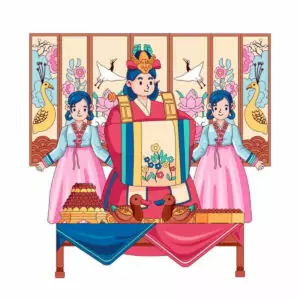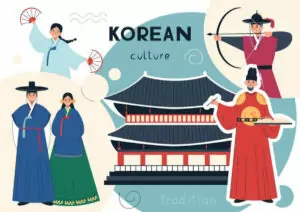When traveling to South Korea, one of the most enjoyable experiences is indulging in authentic Korean cuisine at local restaurants. To fully immerse yourself in the dining culture, it’s essential to familiarize yourself with common restaurant vocabulary in Korean. Whether you’re ordering food, communicating with servers, or simply understanding the menu, these essential Korean phrases will enhance your dining experience and allow you to connect with locals on a deeper level.

✅ AI Essay Writer ✅ AI Detector ✅ Plagchecker ✅ Paraphraser
✅ Summarizer ✅ Citation Generator
Korean Phrases for Dining Out
Learning basic Korean phrases is crucial for effective communication at restaurants. Here are some fundamental expressions to get you started:
- Welcome (어서오세요 – Eoseo oseyo): This polite greeting is commonly used by waiters and waitresses to welcome you to the restaurant.
- How many are in your party? (몇 분이세요? – Myeot bun-iseyo?): This question helps the staff determine the size of your group.
- Please get us a table (테이블로 주세요 – Teibeullo juseyo): Use this phrase to request a table with chairs.
- Room, please (방으로 주세요 – Bang-euro juseyo): If you prefer traditional seating on the floor, use this phrase to request a private room.
- What would you like? (뭐 드시겠어요? – Mwo deusigesseoyo?): This question is posed by the waiter to take your order.
- We will have one order of Kimbap and two orders of Bibimbap, please (김밥 하나랑 비빔밥 둘 주세요 – Gimbap hana-rang bibimbap dul juseyo): Use this phrase to place your food order.
- Enjoy your food (맛있게 드세요 – Masitge deuseyo): This is a common phrase used to wish someone an enjoyable meal.
- Could we get more kimchi and water, please? (아저씨, 여기 김치랑 물 좀 더 주세요 – Ajussi, yeogi kimchi-rang mul jom deo juseyo): If you need additional side dishes or water, use this expression to ask the server.
Ordering in a Korean Eatery (식당 – Sikdang)
In Korea, a “식당” (sikdang) refers to an eatery or restaurant that serves Korean and other Asian cuisines. Here are essential phrases to use when ordering in a sikdang:
- I’ll have the number one (일번 주세요 – Ilbeon juseyo): When ordering from a fast-food restaurant with a numbered menu, this phrase is handy.
- Menu, please (메뉴주세요 – Menyu juseyo): If you want to see the menu, simply use this phrase to request it.
- Check, please (계산서 주세요 – Gyesanseo juseyo): When you’re ready to pay, ask for the bill with this expression.
- Non-smoking seat, please (금연석으로 주세요 – Geumyeonseog-euro juseyo): If you prefer a non-smoking area, use this phrase to request a smoke-free seat.
Ordering at a Market or Street Vendor (시장, 포장마차 – Sijang, Pojangmacha)
At markets or “시장” (sijang) and street vendors or “포장마차” (pojangmacha), you’ll find ready-to-eat foods. Here are phrases to use when ordering at these places:
- What is this? (이거 뭐예요? – Igeo mwoyeyo?): If you’re curious about a food item, use this question to ask what it is.
- How much is it? (얼마에요? – Eolmayeyo?): To inquire about the price, use this common question.
- I’d like one order, please (일인분 주세요 – Il-inbun juseyo): Use this phrase to request a serving of a particular food item.
- Would you like to eat here? (여기서 드실꺼예요? – Yeogiseo deushilggeoyeyo?): If you’re at a street vendor, this question determines whether you’ll eat on the spot or take the food to go.
Counting in Korean
When ordering multiple items or determining quantities, you’ll need to use the appropriate counting system in Korean.
Counting People (인원수 세기 – Inwon-su segi)
To count the number of people, you’ll use the Korean numbering system for counting individuals from one to ten:
- 하나 (Hana) – One
- 둘 (Tul) – Two
- 셋 (Set) – Three
- 넷 (Net) – Four
- 다섯 (Daseot) – Five
- 여섯 (Yeoseot) – Six
- 일곱 (Ilgop) – Seven
- 여덟 (Yeodeol) – Eight
- 아홉 (Ahop) – Nine
- 열 (Yeol) – Ten
To express the number of people, add “명” (myeong), meaning “person,” after the number:
- 한명 (Hanmyeong) – One person
- 두명 (Dumyeong) – Two people
- 세명 (Semyeong) – Three people
- 네명 (Nemyeong) – Four people
- 다섯명 (Daseotmyeong) – Five people
- 여섯명 (Yeoseotmyeong) – Six people
- 일곱명 (Ilgopmyeong) – Seven people
- 여덟명 (Yeodeolmyeong) – Eight people
- 아홉명 (Ahopmyeong) – Nine people
- 열명 (Yeolmyeong) – Ten people
Counting Money (돈 세기 – Don segi)
For counting money or expressing quantities related to prices, use the Chinese numbering system:
- 일)천원 (Il)cheonwon) – 1000 won (천 – cheon)
- 이천원 (Icheonwon) – 2000 won
- 삼천원 (Samcheonwon) – 3000 won
- 사천원 (Sacheonwon) – 4000 won
- 오천원 (Ocheonwon) – 5000 won
- 육천원 (Yukcheonwon) – 6000 won
- 칠천원 (Chilcheonwon) – 7000 won
- 팔천원 (Palcheonwon) – 8000 won
- 구천원 (Gucheonwon) – 9000 won
- 만원 (Manwon) – 10,000 won
- 만삼천원 (Mansaemcheonwon) – 13,000 won
- 오만원 (Omanwon) – 50,000 won
- 육만칠천원 (Yukmanchilcheonwon) – 67,000 won
- 십만원 (Shipmanwon) – 100,000 won
Korean Food Vocabulary
To make the most of your dining experience in Korea, it’s helpful to familiarize yourself with popular Korean dishes and beverages.
Kimchi (김치)
- Pronunciation: Kimchi (김치)
- Translation: Spicy cabbage side dish
김치는 한국 음식에서 가장 인기 있는 반찬 중 하나입니다. (Kimchi-neun Hanguk eumsik-eseo gajang ingi itneun banchan jung hana-ipnida.) – Kimchi is one of the most popular side dishes in Korean cuisine.
Tteokbokki (떡볶이)
- Pronunciation: Tteokbokki (떡볶이)
- Translation: Rice cakes cooked with fish cakes in chili paste
떡볶이는 매콤하고 맛있는 한국 먹거리입니다. (Tteokbokki-neun maekomhago masinneun Hanguk meokgeori-ipnida.) – Tteokbokki is a spicy and delicious Korean street food.
Samgyetang (삼계탕)
- Pronunciation: Samgyetang (삼계탕)
- Translation: Soup with stuffed chicken in the broth
삼계탕은 한국의 전통적인 건강식입니다. (Samgyetang-eun Hanguk-ui jeontongjeogin geongangshig-ipnida.) – Samgyetang is a traditional Korean health food.
Haemul Pajeon (해물파전)
- Pronunciation: Haemul Pajeon (해물파전)
- Translation: Korean pancakes with seafood
해물파전은 바다의 신선한 재료로 만들어져 맛있습니다. (Haemul Pajeon-eun bada-ui sinsanhan jaeryo-ro mandeureojyeo masisseumnida.) – Haemul Pajeon is deliciously made with fresh ingredients from the sea.
Bulgogi (불고기)
- Pronunciation: Bulgogi (불고기)
- Translation: Sweet meat dish
불고기는 달콤한 양념으로 맛있게 구워집니다. (Bulgogi-neun dalkomhan yangnyeomeuro masissege guwojibnida.) – Bulgogi is grilled to perfection with a sweet marinade.
Final Thoughts
Learning essential restaurant vocabulary in Korean will greatly enhance your dining experience in South Korea. The phrases provided here will enable you to confidently order food, interact with servers, and fully enjoy the diverse and delectable Korean cuisine. As you explore the vibrant food culture of Korea, practicing these phrases will undoubtedly deepen your cultural understanding and create lasting memories of your time spent dining out in this captivating country.
So, next time you find yourself in a Korean restaurant, remember to say “맛있게 드세요” (Enjoy your meal) and savor every delicious bite of your dining adventure!
FAQ
What are the different types of dining experiences in Korea?
Korea offers various dining experiences, including sit-down eateries and grab-and-go situations.
How can I request a specific seating arrangement at a Korean restaurant?
You can use phrases like “테이블로 주세요” (table, please) or “방으로 주세요” (room, please) to request specific seating.
What is the payment process at Korean restaurants?
In Korean restaurants, you usually pay at the front, and tipping is not customary. You can pay with cash or credit cards.
What are some common Korean phrases to use when interacting with waiters at a restaurant?
Some common phrases include “어서오세요” (welcome), “뭐 드시겠어요?” (What would you like?), and “감사합니다” (thank you).
Are credit cards widely accepted in Korean restaurants?
Yes, nowadays most places in Korea accept credit cards along with cash for payment.
How do I order food at a market or street vendor in Korea?
You can ask “이거 뭐예요?” (What is this?) to inquire about a food item, and say “일인분 주세요” (I’d like one order, please) to request a serving.
What are some popular Korean dishes I should try at restaurants?
Some popular Korean dishes to try include “Kimchi” (spicy cabbage side dish), “Tteokbokki” (rice cakes in chili paste), “Samgyetang” (soup with stuffed chicken), and “Bulgogi” (sweet meat dish).
Follow us on Reddit for more insights and updates.





Comments (0)
Welcome to A*Help comments!
We’re all about debate and discussion at A*Help.
We value the diverse opinions of users, so you may find points of view that you don’t agree with. And that’s cool. However, there are certain things we’re not OK with: attempts to manipulate our data in any way, for example, or the posting of discriminative, offensive, hateful, or disparaging material.